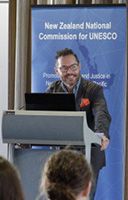Protecting the Multilateral Order:
As we approach the end of 2019, it seems that many assumptions about the robustness of multilateralism, which has underpinned New Zealand’s foreign and trade policy over the past 75 years, are under threat.
It is therefore timely, and very encouraging, to see MFAT tweeting about the importance of multilateralism this week. #multilateralismmatters
Can New Zealand step up to the challenge and become a leader in protecting and restoring genuine multilateralism?
Restoring multilateralism is very much in New Zealand’s interests. We need to be realistic. These are difficult times. But New Zealand has a large store of goodwill internationally. It has credibility and an excellent track record.
I am pleased that the Centre for Global Studies and the UN Association of New Zealand have launched a joint project to explore options for New Zealand to press for the restoration of the mana of multilateralism.
The project will begin in early 2020 with the aim of producing a short report and some practical recommendations for the incoming government after the 2020 election. CGS and UNANZ have only limited resources, but will reach out to interested individuals and groups in civil society to get input and ideas.
The project has evolved against the background of an increasing global push-back against multilateral rules and norms.
- International law is not being respected.
- Human rights and rules governing international trade are routinely violated.
- Negotiators struggle to sustain agreed principles of good governance and environmental protection.
The current trends are reminiscent in some ways of the behaviours in the 1930s that destabilised and ultimately destroyed the League of Nations.
There are demands for states to have the freedom go their own way and to exercise sovereignty unencumbered by international law or the UN Charter.
- In decision-making on war and peace, unilateralism seems to be prevailing over collective security rules.
- Long-term alliances and partnerships are seen as trifling and sometimes as problematic hindrances.
- The UN Security Council is being undermined. Even Permanent Members flagrantly ignore its binding decisions.
- Assertive bilateralism seems to be rearing its ugly head, with some world leaders demanding bilateral outcomes at the expense of collective ones.
This infection is spreading. Even in New Zealand there are echoes on talk-back radio, and in what social media trolls are writing. Some really despise the UN. Others project hatred of the values it stands for.
There used to be an active political consensus in New Zealand on the need to support multilateral institutions and the UN in particular. But all our political parties here seem now to have drifted into a position where, with the exception of climate change, the focus is on other policy priorities. By default, energy and resources have shifted to bilateral activity.
It has been clear, for over a hundred years, that excessive focus on bilateralism leads, ultimately, to diminished outcomes for everyone. We have also learnt that it can create conditions that lead to war.
Bilateralism, because of its binary nature, incentivises outcomes with one winner and one loser. Short-term, this is politically attractive to leaders of large countries. Large countries almost always prevail in these contests. It is therefore a disastrous model for New Zealand and for the 150 or so other small or medium-size countries, whose economies will inevitably falter if this thinking prevails.
Over time, the bilateral model becomes disastrous for everyone, even the large. Global trade shrinks as the number of losers grows. Eventually a point is reached when even the economies of the few remaining winners begin to contract. And that is assuming that there is a long-term at all. Assertive bilateralism can breed desperation, as happened with Japan in the early 1940s. Bilateralism comes to be perceived by the losers as predatory. And, all-out warfare can be the result.
Multilateralism was not invented as a result of some ‘do-gooder’ mentality. To the contrary, it was created out of a very hard-headed conclusion that the world needed an alternative to the binary win/lose dynamic of bilateralism.
Multilateralism incentives win/win outcomes across multiple players. It also incentivises a rules-based system, with independent mechanisms to ensure that agreements are implemented fairly and honestly.
Multilateralism is hard work. It takes time and patience. It does not have flashy short-term political appeal. But long-term, it is the only safe and sustainable mechanism for managing modern international relations. In today’s interconnected world, we cannot solve large and complex problems without a system for agreeing on rules and fairly enforcing them.
This is true for international trade, for preventing conflict, for protecting the environment and ultimately for ensuring our very survival on this planet. The risks of catastrophic climate change and nuclear annihilation cannot be managed bilaterally. The awful situation in Syria is a clear example of total failure to properly use multilateral collective security mechanisms and conflict prevention tools.
But our current multilateral machinery is far from perfect. And after 70 years the UN machinery set up in 1945 is not a good fit with the world of today. It requires major reform. The multilateral trade machinery is much newer. But it too needs some reform.
The Centre and UNANZ accept that it is important, in looking at options for the future, not to be naïve about the UN and other multilateral institutions. Their weaknesses need to be acknowledged. The CGS/UNANZ project will therefore be upfront about the need for reform.
It is time to stop the drift into indifference about multilateralism and the UN. In New Zealand it is time to reverse the drift of resources away from multilateralism. New Zealand is ideally placed to be able to contribute hugely to a transformation of the multilateral institutions.
On trade, on peace and security, on the environment, on peacekeeping, all the New Zealand political parties should be supporting active reengagement in the multilateral arena. And the purpose of the CGS/UNANZ project is to help them by coming up with practical ideas.
I am happy to become part of this project, and look forward to participating in it, during 2020.








